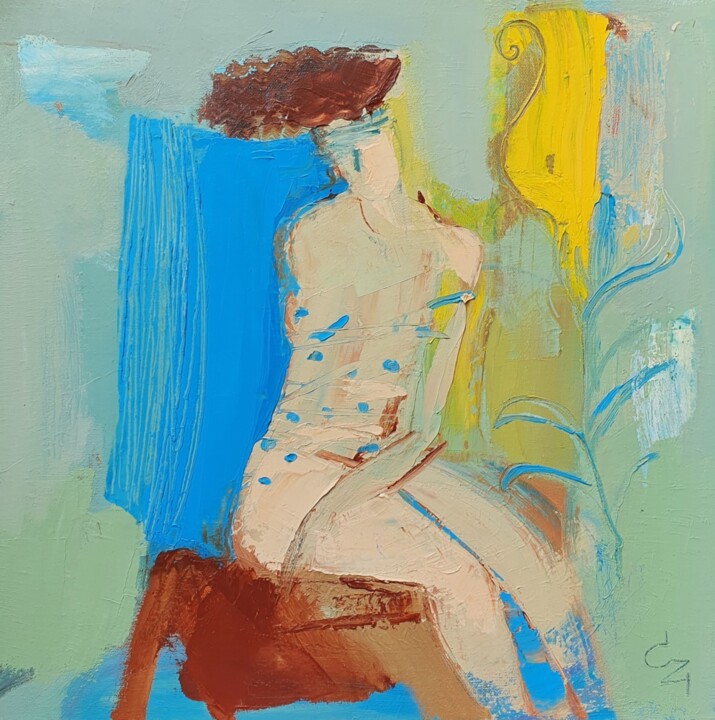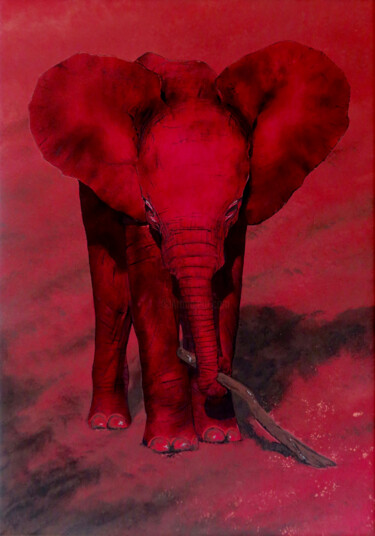 VIBRANT SUNRISE (STRETCHED) (2024)Painting by Nadiia Antoniuk
VIBRANT SUNRISE (STRETCHED) (2024)Painting by Nadiia Antoniuk
Why Expressionism? A bridge between the artistic cultures of Germany and Austria
Among the art movements that developed strongly in both Germany and Austria, some of the most significant include Expressionism, the Bauhaus, and the Vienna Secession. Comparing German and Austrian Expressionism is easier than comparing the Bauhaus and the Vienna Secession. In fact, Expressionism had a wide spread and deep imprint in both Germany and Austria, with a significant number of artists and works that can be analyzed in parallel. This movement was expressed through various art forms such as painting, sculpture, and graphic art, and in both countries Expressionist artists shared similar goals, such as exploring the human condition and expressing inner emotions, albeit with local and personal nuances. Then, it becomes apparent how Expressionism offers a broader common ground for comparison between Germany and Austria, while the Bauhaus and the Vienna Secession, differentiated more in intent, historical contexts, and underlying philosophies, would make the task more arduous and complex.
 MISIFUX (2024)Dipinto di Eva Hidalgo
MISIFUX (2024)Dipinto di Eva Hidalgo
Colors Loaded with Feeling: Understanding Expressionism
Expressionism, an art movement that originated in several cities in Germany, arose as a reaction to growing anxiety about humanity's increasingly disharmonious relationship with the world and the loss of feelings of authenticity and spirituality. Emerging in part as a reaction against Impressionism and academic art, Expressionism drew great inspiration from the Symbolist currents of the late 19th century. Artists such as Vincent van Gogh, Edvard Munch and James Ensor, with their penchant for distorting forms and using intense colors, profoundly influenced the Expressionists, allowing them to express a variety of anxieties and desires.
It was precisely the advent of Expressionism that heralded new standards in the creation and judgment of art. The latter was to spring from within the artist, rather than from the representation of the external visual world, and the criterion for evaluating the quality of a work of art became the character of the artist's feelings, rather than an analysis of composition. Expressionist artists often employed swirling, undulating and "exaggeratedly" executed brushstrokes in the depiction of their subjects. These techniques were intended to convey their turbulent emotional state in reaction to the anxieties of the modern world.
The aforementioned approach to art is also to be understood as a powerful tool of social critique, in which representations of the modern city often include alienated or distressed individuals-a psychological byproduct of recent urbanization-that were used to comment on the role of capitalism in the emotional distancing of individuals within urban contexts.
Expressionism, then, not only revolutionized artistic and visual approaches but also offered profound food for thought about the world, making evident the tensions and contradictions of modern living.
Finally, from a chronological point of view, it is important to highlight how the classical phase of the Expressionist movement, which lasted approximately from 1905 to 1920, spread throughout Europe and subsequently influenced many individuals and groups, including Abstract Expressionism, Neo-expressionism and the London School. Speaking of the contemporary world, through its intense visual language and capacity for emotional expression, Expressionism continues to be a powerful voice in today's figurative dialogue.
 KAZUMI TAUPE - FRAU IN GRÜN, OCKER, SCHWARZ ERNST (2022)Painting by Carolyn Mielke (carographic)
KAZUMI TAUPE - FRAU IN GRÜN, OCKER, SCHWARZ ERNST (2022)Painting by Carolyn Mielke (carographic)
German Expressionism: Origins, development and characteristics of a revolutionary movement
German Expressionism had its roots in the early 20th century, deeply marking the artistic landscape with two of its major groups, "Die Brücke" (The Bridge) and "Der Blaue Reiter" (The Blue Rider).
Founded in 1905 in Dresden, the Die Brücke group aimed to link classical neo-Romantic painting with new forms of expression that would later be identified with Expressionism. Die Brücke members sought a more authentic and intense art, reflecting on the loneliness, alienation and tensions of modern life. They used punchy graphic lines and vivid, saturated colors to express their inner visions, often focusing their works on dynamic, emotionally charged urban scenes. The main exponents of Die Brücke were Ernst Ludwig Kirchner, Erich Heckel, Karl Schmidt-Rottluff, Fritz Bleyl, Emil Nolde and Max Pechstein.
In 1911, Der Blaue Reiter, founded by Vasily Kandinsky and Franz Marc, was born in Munich. This group was distinguished by a more abstract and spiritual approach to art. Der Blaue Reiter focused less on the representation of external reality and more on the expression of spiritual and internal dynamics. This movement placed less emphasis on social tensions and more on universal harmony, exploring the use of color and form to express pure and deep emotions.
While Die Brücke emphasized a raw and direct depiction of the human experience, characterized by incisive and sometimes brutal social criticism, Der Blaue Reiter leaned toward a more lyrical and abstract view of existence, often disconnected from the direct representation of the material world. Der Blaue Reiter's approach to abstractionism laid the groundwork for future artistic currents that developed after World War I.
Do you think I have forgotten masters like Otto Dix? After the war, expressionism evolved into an extremely realistic style, characterized by unprecedented harshness, accompanied by brutality and shocking depictions. These qualities are found precisely in the art of Otto Dix, as well as in the works of Max Beckmann and George Grosz.
 STILL LIFE (2018)Painting by Borys Buryak
STILL LIFE (2018)Painting by Borys Buryak
Austrian Expressionism: History, Characteristics and Exponents
Austrian Expressionism came to life around 1909-1910 in Vienna, with key figures such as Oskar Kokoschka and Egon Schiele pushing painting to new emotional frontiers, achieved through intensely personal portraits. The movement ended tragically due to the ravages of World War I and the Spanish flu epidemic that struck Europe, leading to the untimely deaths of masters such as Gustav Klimt and Schiele himself. This period of intense artistic creativity was further marked by the collapse of the Austro-Hungarian Empire and the deep political uncertainties of the time.
Viennese Expressionism is distinguished by its intense exploration of the human figure, using the body as a vehicle for extreme emotional rendering, often anchored in specific feelings and moods. In a context where abstract movements dominated the art scene, these artists rediscovered the importance of subjects, using vigorous brushstrokes and dynamic forms to infuse "expression" into their works.
 Ernst Ludwig Kirchner, Marzella, 1909 - 1910. Oil on canvas, 76×60 cm. Museet, Stockholm.
Ernst Ludwig Kirchner, Marzella, 1909 - 1910. Oil on canvas, 76×60 cm. Museet, Stockholm.
 Egon Schiele, Two Little Girls, 1911.
Egon Schiele, Two Little Girls, 1911.
Comparison of Ernst Ludwig Kirchner's "Marzella" and Egon Schiele's "Two Little Girls"
The works "Marzella" by Ernst Ludwig Kirchner and "Two Little Girls" by Egon Schiele, despite being both rooted in expressionism, illustrate distinct and personal approaches to the depiction of youth.
Painted between 1909 and 1910, "Marzella" shows a bold exploration of the female portrait. Kirchner uses acid colors such as green and orange, creating a visual contrast that deviates sharply from the serenity typical of portraits of youth. The subject, a naked girl, is seated with her hands crossed over her pubis, in a gesture reminiscent of Edvard Munch's "Puberty," but with a much more mischievous and self-conscious attitude. The setting, enhanced by cushions and decorative objects, along with the use of bright colors and "distorted" shapes, contributes to an atmosphere of decadent luxury. Kirchner expresses in this canvas a critique of the hypocrisy and corruption of contemporary society, reflecting the restlessness of modern man.
On the other hand, "Two Little Girls" of 1911 expresses Schiele's deep interest in the child psyche and innocence, treating his subjects with a sense of introspective realism and vulnerability. Schiele, who described himself as an "eternal child," captures the emotional complexity of growing up through his young models, whom he portrays with a stark but often chaste figurativism. The two girls, depicted in natural, relaxed poses, express a tranquility and spontaneity, which contrast with the emotional intensity more typical of Schiele's works, as well as the disinhibition partially perceptible in "Marzella."
 2 (2019)Painting by Ramadan Hussien
2 (2019)Painting by Ramadan Hussien
 SITZENDE IM GRÜNEN KLEID (2020)Drawing by Barbara Kroll
SITZENDE IM GRÜNEN KLEID (2020)Drawing by Barbara Kroll
German and contemporary Austrian expressionism: female subjects compared
"2" by Ramadan Hussien and "Sitzende im grünen kleid" by Barbara Kroll are two artworks by artists working in Austria and Germany, designed to provide unique and deeply personal perspectives on the female figure, while maintaining a deep connection to the expressionist tradition.
The work by Ramadan Hussien, a Syrian artist living in Austria, was created through the use of acrylic and charcoal on canvas in order to create a "polychromatic" image designed to capture the emotional essence and complexity of the female subject. The bright colors and "distorted" shapes are precisely used to express intense feelings, probably alluding to the effigy's state of mind of inner torment. Again in order to render the latter aspect, Hussien also combined partially abstract details with figurative elements, thus eviscerating a deep interiority, which goes beyond mere visual representation. Finally, bringing energy and movement to the introspective composition are the predominant shades of green, blue and pink, which blend together in a fluid and dynamic manner.
On the other hand, Barbara Kroll, a German artist, takes a more "bare" and "minimalist" approach in the work "Sitzende im grünen Kleid," where the white support emerges from beneath the thick stroke, intended to generate another female form. The latter was created through a combination of conté, acrylic on paper and mixed media, through which Kroll explored the vulnerability and reflexivity of her subject, sometimes pervaded by blurred lines. In regard to the use of colors, however, the German turns out to be once again more restrained and synthetic than her Austrian colleague, as she only makes use of blue, green and red, which are distributed, either in lines or in backgrounds.
Then, it becomes apparent how, although both works demonstrate an intense exploration of human expression and visual language, Hussien employs bright colors and bold shapes to communicate greater emotional movement, while Kroll uses a narrower palette and fluid lines in order to evoke a predominant introspective stillness.
 NUDE 2 (2019)Painting by Borys Buryak
NUDE 2 (2019)Painting by Borys Buryak
 THE YELLOW FLOWER (2022)Painting by Victoria Cozmolici
THE YELLOW FLOWER (2022)Painting by Victoria Cozmolici
Two other expressionist works, concerning a female subject, are "Nude 2" by Borys Buryak and "The Yellow Flower" by Victoria Cozmolici. Starting with Borys Buryak, the Austria-based artist has created a standing nude female figure, aimed at bringing to life a sensual lyricism, which is combined with an intimate atmosphere with a highly introspective flavor. In fact, it is precisely in the sensuality of a dimly lit interior that the beautiful nude woman almost turns her back on us, to raise her hands as if she has seen something interesting in front of the window, probably akin to, or healing, the dramas of her lonely heart.
As for Victoria Cozmolici, the painter, a resident of Germany, has created "The Yellow Flower," a work depicting a seated nude female figure. The emotional intensity of the subject is not now rendered by penumbra, but, on the contrary, by a lively palette and energetic brushstrokes. It is the latter that give form to a figure surrounded by blue, yellow, green, and brown, hues combined to forge figurative elements as well as abstract ones such as thoughts.
Finally, it becomes apparent how kindred motions of the soul are rendered differently by the two paintings, which become capable of making us reflect on how the flow of thought can reach us in any context...


 Olimpia Gaia Martinelli
Olimpia Gaia Martinelli























